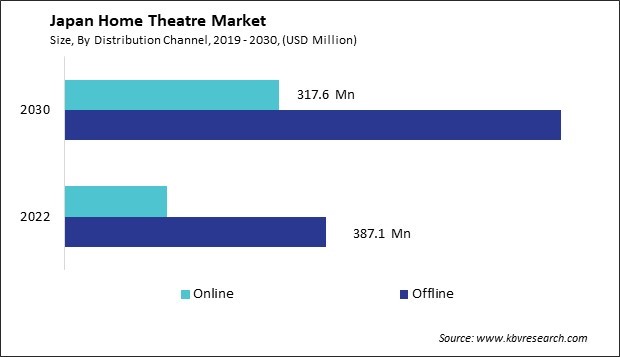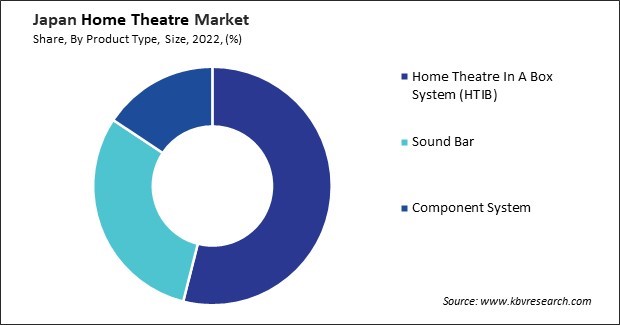Int'l : +1(646) 832-2886 | query@kbvresearch.com
Int'l : +1(646) 832-2886 | query@kbvresearch.com
Published Date : 15-Jul-2024 |
Pages: 94 |
Formats: PDF |
The Japan Home Theatre Market size is expected to reach $1 billion by 2030, rising at a market growth of 8.8% CAGR during the forecast period. In the year 2022, the market attained a volume of 1,460.0 Thousand Units, experiencing a growth of 8.8% (2019-2022).
The home theatre market in Japan has witnessed significant growth over the years. Japanese consumers exhibit a penchant for high-quality audiovisual experiences, leading to a surge in the adoption of advanced home theatre setups. From surround sound systems to high-definition projectors and large-screen displays, households in Japan are increasingly investing in cutting-edge technology to recreate the cinematic experience within their living spaces.

Moreover, the proliferation of smart home devices and integration with voice assistants has revolutionized how home theatre systems are controlled and operated. Japanese consumers value convenience and seamless connectivity, prompting manufacturers to innovate and introduce smart features that cater to these preferences. From voice-activated commands to wireless connectivity options, modern home theatre setups in Japan offer a blend of functionality and user-friendly interfaces.
Furthermore, the influence of gaming culture in Japan has contributed to the growth of the home theatre market, with enthusiasts seeking immersive gaming experiences through high-definition displays and surround sound systems. The rise of streaming platforms such as Twitch, YouTube Gaming, and Facebook Gaming has revolutionized how esports are consumed, providing fans with unprecedented access to live tournaments, player streams, and behind-the-scenes content. Esports tournaments and events have become major attractions in Japan, drawing massive online and offline audiences.
According to the International Trade Administration, the eSports industry in Japan has witnessed remarkable growth, with projections indicating an industry surge to 9.9 billion yen (US$71 million) in 2022, further catapulting to over 18 billion yen (US$129 million) by 2025. As the eSports landscape continues to evolve, it intertwines with other sectors, including Japan's burgeoning home theatre market.
The COVID-19 pandemic has also exerted a significant impact on the home theatre market in Japan. With cinemas temporarily shuttered and outdoor recreational activities restricted, individuals have turned to home theatres as a means of escapism and relaxation. This has led to a surge in demand for home entertainment solutions, including audio systems, projectors, and streaming devices, as Japanese consumers seek to recreate the cinema experience within the confines of their homes.
In recent years, Japan has witnessed a significant rise in the popularity of streaming services within the home theatre market, marking a notable shift in consumer behavior and entertainment consumption patterns. One of the primary drivers behind the increasing prevalence of streaming services is the widespread availability of high-speed internet connectivity across Japan. With the expansion of broadband infrastructure and the proliferation of mobile data networks, consumers now have easier access to online streaming platforms, enabling them to enjoy vast content from the comfort of their homes.
Furthermore, the convenience and flexibility offered by streaming services have contributed to their growing appeal among Japanese consumers. Unlike traditional broadcast television or physical media formats, such as DVDs or Blu-ray discs, streaming platforms allow users to access a diverse selection of movies, TV shows, and other multimedia content on-demand, anytime and anywhere, with just a few clicks or taps on their devices.
Moreover, the increasing prevalence of smart TVs, streaming media players, and connected devices has made it easier for Japanese consumers to integrate streaming services seamlessly into their home entertainment setups. This convergence of technology has transformed traditional home theatres into interconnected hubs of digital entertainment, where Japanese users access a wide range of content sources through a single interface. Therefore, the rise of streaming services in Japan reflects a shift towards convenience fueled by widespread high-speed internet access and seamless integration with modern home entertainment systems.
The home theatre market in Japan is witnessing a significant surge in demand for high-quality entertainment content. One of the primary drivers behind the increasing demand for high-quality entertainment content in the Japanese home theatre market is the growing sophistication of consumers. With advancements in technology and an ever-expanding array of options for accessing content, Japanese consumers have developed discerning tastes and high expectations regarding the audiovisual experiences they seek in their home entertainment setups. As a result, there is a strong demand for content that delivers immersive cinematic experiences.
Furthermore, the proliferation of high-definition (HD), 4K, and even 8K resolution displays has raised the bar for content quality as Japanese viewers seek out content that can fully leverage the capabilities of their cutting-edge home theatre systems. This demand for visually stunning content is driving producers and distributors in Japan to invest in high-resolution filming techniques and post-production processes to ensure that their offerings meet the expectations of discerning audiences.
Moreover, the rise of streaming services and digital distribution platforms has democratized access to premium entertainment content, providing Japanese consumers with unprecedented choice and convenience in selecting what to watch. This shift towards digital consumption has further fueled demand for high-quality content, as viewers in Japan increasingly expect streaming services to offer a diverse catalog of movies, TV shows, and original programming in stunning visual and audio fidelity. Hence, the convergence of sophisticated consumer preferences, advanced technology, and digital distribution platforms is driving a significant surge in demand for high-quality entertainment content in the Japanese home theatre market.

The home theatre market in Japan is a vibrant and technologically advanced industry, reflecting the country's penchant for high-quality audiovisual experiences and cutting-edge electronics. Sharp Corporation is a significant player in the Japanese home theatre market, recognized for its innovative approach to display technology and audio systems. The company offers a range of televisions with advanced features such as 8K resolution and HDR compatibility, delivering breathtaking picture quality to Japanese consumers. In addition to televisions, Sharp provides soundbars and audio systems designed to complement its displays, providing a complete home theatre solution for enthusiasts.
In addition to these industry giants, numerous niche players and startups are making waves in the Japanese home theatre market. Companies like Onkyo Corporation specialize in high-end audio equipment, offering audiophiles premium speakers, amplifiers, and receivers for a truly immersive listening experience. Onkyo's dedication to audio excellence has earned it a loyal following among Japanese consumers seeking uncompromising sound quality in their home theatres.
Furthermore, Japanese companies like Yamaha Corporation have carved out a niche in the home theatre market with their innovative audio solutions. Yamaha offers a range of soundbars, AV receivers, and surround sound systems to deliver immersive audio experiences for movies, music, and gaming. With a focus on advanced audio processing technologies and sleek design, Yamaha products are popular among Japanese consumers looking to elevate their home entertainment setup.
The Japanese home theatre market is also influenced by the country's love for gaming, with companies like Nintendo and Sony Interactive Entertainment offering gaming consoles and accessories that enhance the gaming experience on the big screen. From the Nintendo Switch to the PlayStation 5, these gaming consoles serve as central components of many Japanese home theatre setups, providing hours of entertainment for gamers of all ages. Hence, the Japanese home theatre market is a thriving ecosystem of innovation and competition, with a diverse array of companies catering to Japanese consumers' diverse needs and preferences.
By Distribution Channel
By Product Type